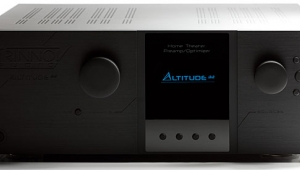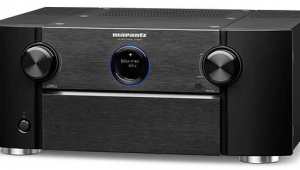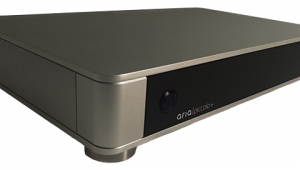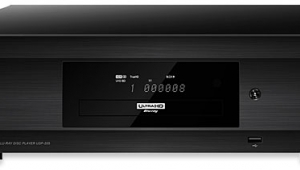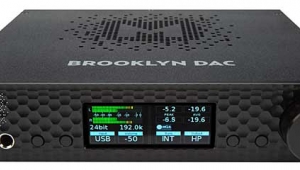| Columns Retired Columns & Blogs |
Music in the Round #37 Page 3
Scrolling through the menus on the neptuneEQ's display (no OSD or other outputs are provided) revealed that it had made relatively subtle adjustments in the outputs of my front left and right B&W 802D loudspeakers (3.5dB max, but typically within an envelope of 0.5–1dB). Slightly more adjustments had been made to the center 802D, whose lower woofer is partly obscured by an upholstered settee, and to the 804S surround speakers. I then swept a pink-noise signal around the room, both with and without the neptuneEQ in circuit, to confirm the settings. The L/R speakers had been minimally affected by the neptuneEQ, the others more so, but the outputs of all sounded much more alike with the Neptune than without it.
Footnote 2: As a presbyopic deuteranope, I won't comment on the Oppo's video performance, but the word is that it's outstanding. I was more than satisfied, and note that the controls for adjusting video setup and picture are extensive. Included with the BDP-83 is a copy of the excellent Spears & Munsil High Definition Benchmark: Blu-ray Edition test disc.
One of the delights of the neptuneEQ is that, after doing an auto setup, the user can tweak the system to taste, something that Audyssey MultEQ Pro doesn't permit. Two adjustments in particular increased my enjoyment. First, I dialed back by 1dB the boosts the neptuneEQ had inserted in the front three channels at 2500 and 3150Hz, which completed those three speakers' disappearing act. The front soundstage was now seamless. I then returned all subwoofer EQ settings to "0," and inserted in the circuit the DSPeaker Anti-Mode 8033 equalizer (see my column in the January 2009 issue). With the 8033, the measured subwoofer output was flatter than with the neptuneEQ—or, for sure, than with the Fathom f113's own single-band correction. On the other hand, when listening, I was hard-pressed to distinguish between the Anti-Mode 8033 and the neptuneEQ. I can imagine more ambitious arrangements of multiple subwoofers, particularly in home theaters, where the higher precision of the 8033's DSP filters might be more effective.
Overall, I was greatly impressed with the performance of the neptuneEQ, and have been enjoying the consistency and transparency it contributes to the sound of my system. My expectations were that it would change the system's harmonic balance, however subtly, and ultimately prove less effective than DSP-based EQ in taming low-frequency room modes. However, with a bit of tweaking—easily added to what it came up with on its own—the neptuneEQ's primary effects were to remove from the equation the acoustics of the room, and to closely match all channels to the sound of the main L/R speakers. The result is that the individual speakers now sound pretty much the same as each other but now the entire system sounds much better.
The neptuneEQ is not inexpensive at $3995, but it provides an otherwise compromised all-analog system with effective automatic and manual room equalization, bass management, and control of channel level/distance. It's not comparable to the Audyssey Sound Equalizer, which can certainly do room EQ but can only recommend settings for bass management and channel level/distance. (You must set those, somehow, in your A/V receiver or pre-pro.) I have not yet used the Audyssey SEQ in this analog system, nor have I used the neptuneEQ in my other, all-digital system, as each seems best suited where it is. So, while I have strong theoretical preferences for the Audyssey approach—see earlier editions of this column—Neptune Audio's neptuneEQ has unique features that commend it highly for some systems. And I'm thrilled with the audible results.
Oppo BDP-83 universal Blu-ray player does it all
Remember when a "universal" player handled CDs, SACDs, and DVD-Audio and -Video discs? Now, with Blu-ray fighting for ascendance in the market and other formats fading, there may not be much of a demand for a do-everything player in the mass market. However, many of us have collections of all of those formats. For us, the launch of a player that plays Blu-ray Discs in addition to those formats would be a reason for celebration.

Oppo Digital is doing just that. Building on its achievements with its DV-980H and DV-983H universal players, Oppo is about to release the BDP-83 Blu-ray universal player ($499), which can also play all the formats listed above, as well as BD-R/RE, HDCD, AVCHD, CD-R/RW, DVD±R/RW, and DVD±R DL. They've housed it in a larger, sturdier, more attractive case than their earlier models, and have created more elegant user interfaces, both on screen and on the new remote control. It provides control of bass management, speaker levels, and speaker distances to permit use with analog preamps, but crossover for Small speakers is restricted to 80Hz, a useful but not universal value.
My review sample was officially a beta unit—the firmware had not yet been finalized (is it ever?)—and the BDP-83 continues to appear on Oppo's website as "coming soon." However, several hundred beta units are now in the hands of members of Oppo's Early Adopters Program, and Oppo has assured me that the hardware platform is stable. As shipped, my review sample couldn't play DVD-As. That capability was added with a firmware update, although DVD-A operation remains quirky. A few DVD-As still won't play correctly, but Oppo expects to iron out these issues before the formal launch. Consider the following comments preliminary, and primarily based on my experience of the BDP-83's performance with CDs, SACDs, and Blu-rays.
The stereo and multichannel analog outputs have been upgraded from earlier Oppo models, and sound it. The analog output of the DV-980H was usable, but not in the class of the comparably featured Pioneer DV-58. The BDP-83 is in that class. Compared to the DV-980, the BDP-83 didn't sound thin but widely balanced, with excellent clarity in the high frequencies. Dynamics, too, are improved. However, comparing the Oppo's playing of two-channel SACDs with that of the Sony SCD-XA5400ES, I could hear that the Oppo can't compete with the better dedicated players. The Sony is just so much more delicate in its delineations, while giving away nothing in dynamic subtlety or range. By analogy to video, the Oppo's audio performance is like good video performance with a little too much contrast. Using the Oppo's HDMI output for audio, the gap in performance between the BDP-83 and its predecessors, or the Sony, narrowed but remained.
As a Blu-ray player, the BDP-83 was a delight.2 Setup was a breeze, disc-load times are greatly improved, and the new remote makes navigating the menus almost not a chore. I listened to two 2L audio-only Blu-rays, Divertimenti (2L 50) and Magnar Åm's SONaR (2L 51), and Johann Strauss, Jr.'s Die Fledermaus (Opus Arte OABD7004D). Via its analog outputs, the BDP-83 was nearly in the class of the Denon DVD-3800BDCI Blu-ray player. I couldn't A/B the two players, but I felt a bit more relaxed with the Denon. On the other hand, both were so enjoyable for extended listening—and viewing—that I often forgot I was supposed to be making critical analyses and let myself just enjoy the music. Again, HDMI narrowed any subjective differences, in this case to nil with the Integra DTC-9.8 preamp/processor.
That I can comfortably alternate this new player with dedicated players costing three to seven times as much makes the Oppo BDP-83 almost self-recommending. However, some quirks in my beta unit need to be addressed, including intermittent ticks during playback of SACDs and BDs. Others have reported lockups with some BD movies. I'm certain that Oppo is addressing these issues, and we'll stay on top of them. Just wait for the official release.
Next Time in the Round: Unfinished Business
I had hoped to have a follow-up report on the performance of the Sony SCD-XA5400ES SACD player with one or more high-end preamplifier-processors, but since none of the latter have been delivered, I can't say much. I did take the Sony to a local audio emporium and found that, with at least one that lacks DSD decoding (an original Classé SSP-800), there was no HDMI output from the SACD tracks, only from CD tracks. A non-hybrid SACD permitted no HDMI output at all. Still, my enthusiasm for the Sony is so great that you can be assured of further reports (footnote 3). Similarly, I'm curious if more sophisticated pre-pros will further improve the sound of the Sony and other players. Of course, that will be contingent on my receiving the appropriate multichannel processors. Those promised include the Anthem D2v and the Simaudio Moon Evolution CP-8, along with the Meridian HD621 HDMI audio processor, to bring my Meridian Reference 861 into the 21st century. Also to be reported on are some big bass traps for my Manhattan listening room.
Footnote 2: As a presbyopic deuteranope, I won't comment on the Oppo's video performance, but the word is that it's outstanding. I was more than satisfied, and note that the controls for adjusting video setup and picture are extensive. Included with the BDP-83 is a copy of the excellent Spears & Munsil High Definition Benchmark: Blu-ray Edition test disc.
Footnote 3: Before returning the AV888 to Arcam, I hooked it up to Sony's SCD-XA5400ES SACD/CD player in my Connecticut system (see my review of the Sony in the May 2009 Stereophile). I wanted to take another stab at confirming my conclusion, reached after a trial at a local audio shop of the Sony with an early Classé SSP-800 preamplifier-processor, that the Sony wouldn't output PCM via HDMI from SACDs (See "Music in the Round," July 2009). Sony's PR agency insisted that the SCD-XA5400ES would output PCM via HDMI, but there's no mention of it in Sony's documents, and no user control of the HDMI data format. With the Classé SSP-800, DSD tracks were silent; only "Red Book" CD datastreams worked via HDMI.
But, lo and behold, the Arcam AV888's display read "Digital PCM 5.1" when I selected the Sony while playing SACDs, and music blossomed forth from all channels with every SACD I tried, whether 5.1-, 5.0-, 4.0-, or 2.0-channel. Arcam's Nick Clarke confirmed that his company is very persnickety about EDID, the handshaking protocol by which HDMI-linked products communicate, and that the AV888 won't accept a DSD signal—so I must have been hearing PCM signals. Apparently, that early Classé pre-pro was sending the Sony the wrong message. I took the Sony back to my Manhattan apartment, where I hooked it up to my Meridian HD621/861, with similar success.
I wonder if anyone else has tried to see if the Sony would output PCM via HDMI from SACDs with any linked components, as no one has challenged my published statements that it wouldn't. I apologize to anyone who may have accepted those statements at face value, and to Sony for my having misrepresented their excellent SCD-XA5400ES SACD/CD, which indeed does output PCM and DSD via HDMI.
- Log in or register to post comments


